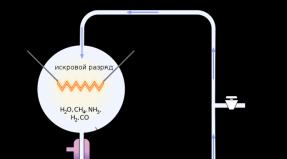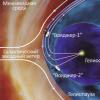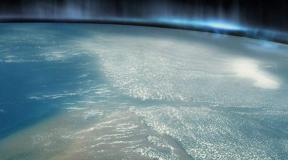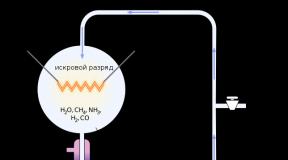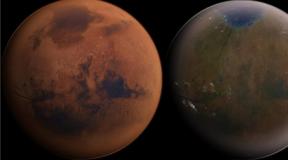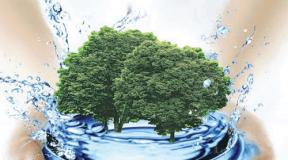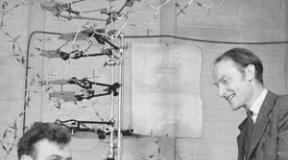How did life originate on earth? How life actually began on Earth. Development of ideas about the emergence of life
The emergence of life on Earth
The problem of the origin of life has now acquired an irresistible fascination for all humanity. It not only attracts the close attention of scientists from different countries and specialties, but is of interest to all people of the world. It is now generally accepted that the emergence of life on Earth was a natural process, completely amenable to scientific research. This process was based on the evolution of carbon compounds, which occurred in the Universe long before the emergence of our Solar System and only continued during the formation of planet Earth - during the formation of its crust, hydrosphere and atmosphere.
Since the origin of life, nature has been in continuous development. The process of evolution has been going on for hundreds of millions of years, and its result is a diversity of living forms that, in many ways, has not yet been fully described and classified.
The question of the origin of life is difficult to study because when science approaches the problems of development as the creation of a qualitatively new thing, it finds itself at the limit of its capabilities as a branch of culture based on evidence and experimental verification of statements.
Scientists today are unable to reproduce the process of the origin of life with the same accuracy as it was several billion years ago. Even the most carefully staged experiment will be only a model experiment, devoid of a number of factors that accompanied the appearance of life on Earth. The difficulty lies in the impossibility of conducting a direct experiment on the origin of life (the uniqueness of this process prevents the use of the basic scientific method).
The question of the origin of life is interesting not only in itself, but also because of its close connection with the problem of distinguishing living from non-living things, as well as its connection with the problem of the evolution of life.
Chapter 1. What is life? Difference between living and nonliving.
To understand the patterns of evolution of the organic world on Earth, it is necessary to have a general understanding of the evolution and basic properties of living things. To do this, it is necessary to characterize living beings in terms of some of their characteristics and highlight the main levels of organization of life.
It was once believed that living things could be distinguished from non-living things by properties such as metabolism, mobility, irritability, growth, reproduction, and adaptability. But the analysis showed that separately all these properties are found among inanimate nature, and therefore cannot be considered as specific properties of the living. In one of the last and most successful attempts, living things are characterized by the following features, formulated by B. M. Mednikov in the form of axioms of theoretical biology:
All living organisms turn out to be a unity of a phenotype and a program for its construction (genotype), which is inherited from generation to generation (axioms of A. Weisman).
The genetic program is formed in a matrix way. The gene of the previous generation is used as a matrix on which the gene of the future generation is built (axiom a of N.K. Koltsov).
In the process of transmission from generation to generation, genetic programs, as a result of various reasons, change randomly and in no direction, and only by chance such changes can be successful in a given environment (1st axiom of Charles Darwin).
Random changes in genetic programs during the formation of phenotype a are amplified many times over (axiom a by N.V. Timofeev-Resovsky).
Repeatedly enhanced changes in genetic programs are subject to selection by environmental conditions (2nd axiom of Charles Darwin).
“Discreteness and integrity are two fundamental properties of the organization of life on Earth. Living objects in nature are relatively isolated from each other (individuals, populations, species). Any individual multicellular animal consists of cells, and any cell and unicellular creatures consist of certain organelles. Organelles consist of discrete high-molecular organic substances, which in turn consist of discrete atoms and elementary particles. At the same time, a complex organization is unthinkable without the interaction of its parts and structures - without integrity.”
The integrity of biological systems is qualitatively different from the integrity of nonliving systems, and primarily in that the integrity of the living is maintained in the process of development. Living systems are open systems; they constantly exchange substances and energy with the environment. They are characterized by negative entropy (increased order), which apparently increases in the process of organic evolution. It is likely that living things exhibit the ability to self-organize matter.
“Among living systems, no two individuals, populations or species are alike. This unique manifestation of the discreteness and integrity of the living is based on the remarkable phenomenon of covariant reduplication.
Covariant reduplication (self-reproduction with changes), carried out on the basis of the matrix principle (the sum of the first three axioms), is apparently the only property specific to life (in the form of its existence on Earth known to us). It is based on the unique ability for self-reproduction of the main control systems (DNA, chromosomes and genes).”
“Life is one of the forms of existence of matter, which naturally arises under certain conditions in the process of its development.”
So, what is living and how does it differ from non-living? The most precise definition of life was given about 100 years ago by F. Engels: “Life is a way of existence of protein bodies, and this way of existence consists essentially in the constant self-renewal of the chemical components of these bodies.” The term “protein” was not yet fully defined and was usually referred to protoplasm as a whole. Aware of the incompleteness of his definition, Engels wrote: “Our definition of life, of course, is very insufficient, since it is far from covering all the phenomena of life, but, on the contrary, is limited to the most general and simplest among them... To obtain a truly comprehensive idea of life , we would have to trace all the forms of its manifestation, from the lowest to the highest.”
In addition, there are several fundamental differences between living and nonliving in material, structural and functional terms. In material terms, living things necessarily include highly ordered macromolecular organic compounds called biopolymers - proteins and nucleic acids (DNA and RNA). Structurally, living things differ from non-living things in their cellular structure. Functionally, living bodies are characterized by self-reproduction. Stability and reproduction also exist in non-living systems. But in living bodies there is a process of self-reproduction. It is not something that reproduces them, but they themselves. This is a fundamentally new moment.
Also, living bodies differ from nonliving ones in the presence of metabolism, the ability to grow and develop, the active regulation of their composition and functions, the ability to move, irritability, adaptability to the environment, etc. An integral property of the living is activity, activity. “All living beings must either act or perish. A mouse must be in constant motion, a bird must fly, a fish must swim, and even a plant must grow.”
Life is possible only under certain physical and chemical conditions (temperature, the presence of water, a number of salts, etc.). However, the cessation of life processes, for example when drying seeds or deep freezing of small organisms, does not lead to loss of viability. If the structure remains intact, it ensures the restoration of life processes when returning to normal conditions.
However, a strictly scientific distinction between living and nonliving things encounters certain difficulties. For example, viruses outside the cells of another organism do not possess any of the attributes of a living thing. They have a hereditary apparatus, but lack the basic enzymes necessary for metabolism, and therefore they can grow and multiply only by penetrating the cells of the host organism and using its enzyme systems. Depending on what feature we consider important, we classify viruses as living systems or not.
So, summing up all of the above, let's give a definition of life:
“Life is the process of existence of biological systems (for example, a cell, a plant organism, an animal), the basis of which is complex organic substances and capable of self-reproduction, maintaining their existence as a result of the exchange of energy, matter and information with the environment.”
Chapter 2. Concepts of the origin of life.
a) The idea of spontaneous origin.
At first, the problem of the origin of life did not exist in science at all, because the scientists of the ancient world accepted the possibility of the constant emergence of living things from non-living things. The great Aristotle (4th century BC) had no doubt about the spontaneous generation of frogs. The philosopher Plotinus, in the 3rd century BC, argued that living things are spontaneously generated in the earth through the process of decay. This idea of the spontaneous generation of organisms apparently seemed very convincing to many generations of our distant ancestors, since it existed without changing for many centuries, until the 17th century.
b) The idea of the origin of life according to the principle “living - from living.”
In the 17th century, the experiments of the Tuscan physician Francesco Redi showed that without flies, worms would not be found in rotting meat, and if organic solutions were boiled, microorganisms would not be able to arise in them at all. And only in the 60s. The 19th century French scientist Louis Pasteur demonstrated in his experiments that microorganisms appear in organic solutions only because an embryo had previously been introduced there.
Thus, Pasteur's experiments had a double meaning -
They proved the inconsistency of the concept of the spontaneous origin of life.
They substantiated the idea that all modern living things come only from living things.
c) The idea of the cosmic origin of life.
Around the same period when Pasteur demonstrated his experiments, the German scientist G. Richter developed the theory of the introduction of living beings to Earth from space. He argued that the embryos could have fallen to Earth along with cosmic dust and meteorites and marked the beginning of the evolution of living things, which gave rise to all the diversity of earthly life. This concept was called the concept of panspermia. It was shared by such scientists as G. Helmholtz and W. Thompson, which contributed to its wide dissemination in scientific circles. But it did not receive scientific proof, since primitive organisms or embryos would have died under the influence of ultraviolet rays and cosmic radiation.
d) A. I. Oparin’s hypothesis.
In 1924, the book “The Origin of Life” by the Soviet scientist A.I. Oparin was published, where he experimentally proved that organic substances can be formed abiogenically by the action of electric charges, thermal energy and ultraviolet rays on gas mixtures containing water vapor, ammonia, methane, etc. Under the influence of various natural factors, the evolution of hydrocarbons led to the formation of amino acids, nucleides and their polymers, which, as the concentration of organic substances in the primary broth of the hydrosphere increased, contributed to the formation of colloidal systems, the so-called coacervates, which, released from the environment and having different internal structures, they reacted differently to the external environment. The transformation of carbon compounds during the chemical period of evolution was facilitated by the atmosphere with its reducing properties, which then began to acquire oxidizing properties, which is characteristic of the atmosphere at the present time.
Oparin's hypothesis contributed to a concrete study of the origin of the simplest forms of life. It marked the beginning of physicochemical modeling of the processes of formation of molecules of amino acids, nucleic bases, and hydrocarbons under the conditions of the supposed primary atmosphere of the Earth.
e) Modern concepts of the origin of life.
Today, the problem of the origin of life is being studied by a wide range of different sciences. Depending on what is the most fundamental property of living things that is being studied and predominates in a given study (matter, information, energy), all modern concepts of the origin of life can be divided conditionally into:
The concept of the substrate origin of life (it is adhered to by biochemists led by A.I. Oparin).
Energy origin concept. It is being developed by leading synergetics scientists I. Prigogine, M. Eigen.
The concept of information origin. It was developed by A. N. Kolmogorov, A. A. Lyapunov, D. S. Chernavsky.
Concept of gene origin.
The author of this concept is the American geneticist G. Meller. He admits that a living molecule capable of reproducing could arise suddenly, by chance, as a result of the interaction of the simplest substances. He believes that the elementary unit of heredity - the gene - is also the basis of life. And life in the form of a gene, in his opinion, arose through a random combination of atomic groups and molecules that existed in the waters of the primordial ocean. But mathematical calculations of this concept show the complete improbability of such an event.
F. Engels was one of the first to express the idea that life did not arise suddenly, but was formed during a long path of evolutionary development of matter. The evolutionary idea is the basis for the hypothesis of a complex, multi-stage path of development of matter that preceded the origin of life on Earth.
Modern biologists prove that there is no universal formula for life (that is, one that would fully reflect its essence) and cannot exist. Such an understanding presupposes a historical approach to biological knowledge as comprehension of the essence of life, during which the very concepts of the origin of life and ideas about the forms in which such knowledge is possible changed.
Bioenergy-information exchange as the basis for the emergence of life.
One of the newest concepts of the origin of life on Earth is the concept of bioenergy-information exchange. The concept of bioenergy information exchange arose in the field of biophysics, bioenergy and ecology in connection with the latest achievements in these areas of science. The term bioenergy informatics was introduced by Doctor of Technical Sciences, Professor at Moscow State Technical University. N. E. Bauman V. N. Volchenko in 1989, when his like-minded people held the first All-Union Conference on Bioenergy Informatics in Moscow.
The study of bioenergy-information exchange gave grounds to make an assumption about the informational unity of the Universe, about the presence in it of such a substance as “Information - Consciousness”, and not just known forms of matter and energy, etc.
One of the elements of this concept is the presence in the Universe of a general plan, a plan. This hypothesis is confirmed by modern astrophysics, according to which the fundamental properties of the Universe, the values of the basic physical constants and even the forms of physical laws are closely related to the structure of the Universe on all its scales and to the possibility of Life.
This implies the second element of the concept of bioenergy informatics - the Universe must be considered as a living system. And in living systems, the factor of Consciousness (information), along with matter and energy, should occupy a very significant place. Thus, we can talk about the need for the trinity of the Universe: matter, energy and information.
Chapter 3. How life appeared on Earth.
The modern concept of the origin of life on Earth is the result of a broad synthesis of the natural sciences, many theories and hypotheses put forward by researchers in various specialties.
For the emergence of life on Earth, the primary atmosphere (of the planet) is important. The Earth's primary atmosphere contained methane, ammonia, water vapor and hydrogen. It was by influencing the mixture of these gases with electric charges and ultraviolet radiation that scientists were able to obtain complex organic substances that make up living proteins. The elementary “building blocks” of life are such chemical elements as carbon, oxygen, nitrogen and hydrogen. A living cell by weight contains 70 percent oxygen, 17 percent carbon, 10 percent hydrogen, 3 percent nitrogen, followed by phosphorus, potassium, chlorine, sulfur, calcium, sodium, magnesium, and iron. So, the first step towards the emergence of life is the formation of organic substances from inorganic ones. It is associated with the presence of chemical “raw materials”, the synthesis of which can occur under certain radiation, pressure, temperature, humidity. The emergence of the simplest living organisms was preceded by a long chemical evolution. From a relatively small number of compounds (as a result of natural selection), substances with properties suitable for life arose. Compounds arising from carbon formed the “primary broth” of the hydrosphere. According to scientists, substances containing nitrogen and carbon originated in the molten depths of the Earth and were brought to the surface during volcanic activity. The second step in the emergence of compounds is associated with the emergence in the primary ocean of the Earth of ordered complex substances - biopolymers: nucleic acids, proteins. How were biopolymers formed?
If we assume that during this period all organic compounds were in the primary ocean of the Earth, then more complex organic compounds could have formed on the surface of the ocean in the form of a thin film and in shallow water heated by the sun. An oxygen-free environment facilitated the synthesis of polymers from inorganic compounds. Oxygen, as a strong oxidizing agent, would destroy the resulting molecules. Relatively simple organic compounds began to combine into large biological molecules. Enzymes were formed - protein substances-catalysts that contribute to the formation or disintegration of molecules. As a result of the activity of enzymes, the most important “primary elements of life” arose - nucleic acids, complex polymeric substances (consisting of monomers). Monomers in nucleic acid cells are arranged in such a way that they carry certain information, a code, which consists in the fact that each amino acid included in the protein corresponds to a certain set of three nucleotides, the so-called nucleic acid triplet. Proteins can already be built on the basis of nucleic acids and exchange of matter and energy with the external environment can take place. The symbiosis of nucleic acids formed “molecular genetic control systems.”
This stage, apparently, was the starting point, a turning point in the emergence of life on Earth. Molecules of nucleic acids acquired the properties of self-reproduction of their own kind and began to control the process of formation of protein substances. The origins of all living things were revertase and matrix synthesis from DNA to RNA, the evolution of the RNA molecular system into the DNA one. This is how the “genome of the biosphere” arose.
Heat and cold, lightning, ultraviolet reaction, atmospheric electrical charges, gusts of wind and water jets - all this ensured the onset or attenuation of biochemical reactions, the nature of their course, and gene “bursts”. Towards the end of the biochemical stage, such structural formations as membranes appeared, delimiting a mixture of organic substances from the external environment.
Membranes have played a major role in the construction of all living cells. The bodies of all plants and animals are made up of the basic units of life—cells. The living content of the cell is protoplasm. Modern scientists have come to the conclusion that the first organisms on Earth were single-celled prokaryotes - organisms lacking a nucleus (“karyo” - translated from Greek as “core”). In their structure, they now resemble bacteria or blue-green algae.
For the existence of the first “living” molecules, prokaryotes, an influx of energy from the outside is necessary, as for all living things. Each cell is a small “energy station”. The direct source of energy for cells is adenosine triphosphoric acid and other compounds containing phosphorus. Cells receive energy from food; they are capable of not only spending, but also storing energy.
The subject of discussion is the question of whether one type of organism first appeared on Earth or a great many of them appeared. It is believed that many of the first lumps of living protoplasm arose.
Approximately 2 billion years ago, a nucleus appeared in living cells. From prokaryotes, eukaryotes emerged - single-celled organisms with a nucleus. There are 25-30 species of them on Earth. The simplest of them are amoebas. In eukaryotes, the cell has a formed nucleus with a substance containing the code for protein synthesis. Around this time, a “choice” of a plant or animal lifestyle began to emerge. The main difference between these lifestyles is related to the way of nutrition, with the emergence of such an important process for life on Earth as photosynthesis. Photosynthesis involves creating organic substances, such as sugars, from carbon dioxide and water using energy and light. Thanks to photosynthesis, plants produce organic substances, due to which the plant mass increases.
Conclusion.
Over the past ten years, understanding the origins of life has made enormous strides. We can only hope that the next decade will bring even more: new research is very active in many areas.
But, precisely, the theory of evolution makes it possible to understand the optimal strategy for the relationship between man and the surrounding living nature, and allows us to raise the question of developing the principles of controlled evolution. Individual elements of such controlled evolution are already visible today, for example, in attempts not at simple commercial use, but at economic management of the evolution of individual species of animals and plants.
Studying evolutionary processes is important for environmental protection. Man, invading nature, has not yet learned to foresee and prevent the undesirable consequences of his intervention. People use hexachlorane, mercury preparations and many other toxic substances to control pests. This immediately leads to nature’s evolutionary “response” - the emergence of pesticide-resistant insect races, “super rats” resistant to anticoagulants, etc.
Industrial pollution is often just as catastrophic. Millions of tons of washing powders, entering wastewater, kill higher organisms and cause unprecedented development of cyanide and some microorganisms. Evolution in these cases takes on ugly forms, and it is possible that in the future humanity will face an unexpected “evolutionary threat” from some super-resistant microorganisms, bacteria and cyanides to industrial pollution, which will be able to change the appearance of our planet in an undesirable direction.
Bibliography
1. Agapova O. V., Agapov V. I. Lectures on the concepts of modern natural science. University course. – Ryazan, 2000.
2. Vernadsky V.I. The beginning and eternity of life. – M.: Republic, 1989.
3. Gorelov A. A. Concepts of modern natural science. – M.: Mysl, 2000.
4. Dubnischeva G. D. Concepts of modern natural science: Textbook. for students universities / Ed. M. F. Zhukova. – Novosibirsk: UKEA, 1999.
5. Concepts of modern natural science. Series "Textbooks and teaching aids". – Rostov n/d, 2000.
6. Nikolov T. “The Long Path of Life”, M., Mir, 1999. Selye G. From dreams to discovery. – M., 2001.
7. Ponnamperuma S. “The Origin of Life”, M., Mir, 1999.
8. Soviet encyclopedic dictionary. - M.: Sov. encyclopedia, 2002.
9. Yablokov A.V., Yusufov A.G. Evolutionary doctrine (Darwinism): Textbook. for biol. specialist. universities – 3rd ed. – M.: Higher. school,
The origin of life on Earth is a key and unresolved problem in natural science, often serving as the basis for a clash between science and religion. If the presence in nature of the evolution of living matter can be considered proven, since its mechanisms have been revealed, archaeologists have discovered ancient, more simply structured organisms, then not a single hypothesis of the origin of life has such an extensive evidence base. We can observe evolution with our own eyes, at least in selection. No one has succeeded in creating living things from non-living things.
Despite the large number of hypotheses about the origin of life, only one of them has an acceptable scientific explanation. This is a hypothesis abiogenesis- long-term chemical evolution, which took place in the special conditions of the ancient Earth and preceded biological evolution. At the same time, simple organic substances were first synthesized from inorganic substances, then more complex ones, then biopolymers appeared, the next stages are more speculative and hardly provable. The abiogenesis hypothesis has many unsolved problems and different views on certain stages of chemical evolution. However, some of its points have been confirmed experimentally.
Other hypotheses for the origin of life - panspermia(bringing life from space), creationism(creation by the creator), spontaneous generation(living organisms suddenly appear in inanimate matter), steady state(life has always existed). The impossibility of spontaneous generation of life in nonliving things was proven by Louis Pasteur (19th century) and a number of scientists before him, but not so categorically (F. Redi - 17th century). The panspermia hypothesis does not solve the problem of the origin of life, but transfers it from Earth to outer space or to other planets. However, it is difficult to refute this hypothesis, especially those of its representatives who claim that life was brought to Earth not by meteorites (in this case, living things could burn in the layers of the atmosphere, be subjected to the destructive effects of cosmic radiation, etc.), but by intelligent beings. But how did they get to Earth? From the point of view of physics (the enormous size of the Universe and the impossibility of overcoming the speed of light), this is hardly possible.
For the first time possible abiogenesis was substantiated by A.I. Oparin (1923-1924), later this hypothesis was developed by J. Haldane (1928). However, the idea that life on Earth could have been preceded by the abiogenic formation of organic compounds was already expressed by Darwin. The theory of abiogenesis has been refined and is being refined by other scientists to this day. Its main unresolved problem is the details of the transition from complex non-living systems to simple living organisms.
In 1947, J. Bernal, based on the developments of Oparin and Haldane, formulated the theory of biopoiesis, identifying three stages in abiogenesis: 1) abiogenic emergence of biological monomers; 2) formation of biopolymers; 3) the formation of membranes and the formation of primary organisms (protobionts).
Abiogenesis
The hypothetical scenario for the origin of life according to the theory of abiogenesis is described below in general terms.
The age of the Earth is about 4.5 billion years. According to scientists, liquid water on the planet, so necessary for life, appeared no earlier than 4 billion years ago. At the same time, 3.5 billion years ago, life already existed on Earth, which is proven by the discovery of rocks of such ages with traces of the vital activity of microorganisms. Thus, the first simplest organisms arose relatively quickly - in less than 500 million years.
When the Earth first formed, its temperature could reach 8000 °C. As the planet cooled, metals and carbon, the heaviest elements, condensed and formed the earth's crust. At the same time, volcanic activity occurred, the crust moved and compressed, folds and breaks formed on it. Gravitational forces led to compaction of the crust, which released energy in the form of heat.
Light gases (hydrogen, helium, nitrogen, oxygen, etc.) were not retained by the planet and went into space. But these elements remained in the composition of other substances. Until the temperature on Earth dropped below 100 °C, all water was in a vapor state. After the temperature dropped, evaporation and condensation were repeated many times, and there were heavy downpours and thunderstorms. Hot lava and volcanic ash, once in the water, created different environmental conditions. In some, certain reactions could occur.
Thus, the physical and chemical conditions on the early Earth were favorable for the formation of organic and inorganic substances. The atmosphere was of a reducing type, there was no free oxygen and no ozone layer in it. Therefore, ultraviolet and cosmic radiation penetrated the Earth. Other sources of energy were the heat of the earth's crust, which had not yet cooled, erupting volcanoes, thunderstorms, and radioactive decay.
The atmosphere contained methane, carbon oxides, ammonia, hydrogen sulfide, cyanide compounds, and water vapor. A number of simple organic substances were synthesized from them. Next, amino acids, sugars, nitrogenous bases, nucleotides and other more complex organic compounds could be formed. Many of them served as monomers for future biological polymers. The absence of free oxygen in the atmosphere favored the occurrence of reactions.
Chemical experiments (first in 1953 by S. Miller and G. Ury), simulating the conditions of the ancient Earth, proved the possibility of abiogenic synthesis of organic substances from inorganic ones. By passing electric discharges through a gas mixture that simulated the primitive atmosphere, in the presence of water vapor, amino acids, organic acids, nitrogenous bases, ATP, etc. were obtained.

It should be noted that in the ancient atmosphere of the Earth, the simplest organic substances could be formed not only abiogenically. They were also brought from space and contained in volcanic dust. Moreover, these could be quite large amounts of organic matter.
Low molecular weight organic compounds accumulated in the ocean, creating the so-called primordial soup. The substances were adsorbed on the surface of clay deposits, which increased their concentration.
Under certain conditions of the ancient Earth (for example, on clay, the slopes of cooling volcanoes), polymerization of monomers could occur. This is how proteins and nucleic acids were formed - biopolymers, which later became the chemical basis of life. In an aqueous environment, polymerization is unlikely, since depolymerization usually occurs in water. Experiments have proven the possibility of synthesizing a polypeptide from amino acids in contact with pieces of hot lava.
The next important step on the path to the origin of life is the formation of coacervate droplets in water ( coacervates) from polypeptides, polynucleotides, and other organic compounds. Such complexes could have a layer on the outside that imitates a membrane and maintains their stability. Coacervates were experimentally obtained in colloidal solutions.
Protein molecules are amphoteric. They attract water molecules to themselves so that a shell forms around them. The resulting colloidal hydrophilic complexes are isolated from the water mass. As a result, an emulsion is formed in water. Next, the colloids merge with each other and coacervates are formed (the process is called coacervation). The colloidal composition of the coacervate depended on the composition of the medium in which it was formed. In different reservoirs of the ancient Earth, coacervates with different chemical compositions were formed. Some of them were more stable and could, to a certain extent, carry out selective metabolism with the environment. A kind of biochemical natural selection took place.
Coacervates are capable of selectively absorbing certain substances from the environment and releasing into it certain products of chemical reactions occurring in them. It's like metabolism. As the substances accumulated, the coacervates grew, and when they reached critical sizes, they disintegrated into parts, each of which retained the features of the original organization.
Chemical reactions could occur within the coacervates themselves. Enzymes could be formed when metal ions were absorbed by coacervates.
In the process of evolution, only those systems remained that were capable of self-regulation and self-reproduction. This marked the onset of the next stage in the origin of life - the emergence protobionts(according to some sources, this is the same as coacervates) - bodies that have a complex chemical composition and a number of properties of living beings. Protobionts can be considered as the most stable and successfully obtained coacervates.
The membrane could be formed in the following way. Fatty acids combined with alcohols to form lipids. Lipids formed films on the surface of reservoirs. Their charged heads face the water, and their non-polar ends face outward. Protein molecules floating in water were attracted to the lipid heads, resulting in the formation of double lipoprotein films. The wind could bend such a film, and bubbles would form. Coacervates may have been accidentally trapped in these vesicles. When such complexes again appeared on the surface of the water, they were covered with a second lipoprotein layer (due to hydrophobic interactions with the nonpolar ends of the lipids facing each other). The general layout of the membrane of today's living organisms is two layers of lipids inside and two layers of proteins located at the edges. But over millions of years of evolution, the membrane has become more complex due to the inclusion of proteins immersed in the lipid layer and penetrating it, protrusion and invagination of individual sections of the membrane, etc.
Coacervates (or protobionts) could contain already existing nucleic acid molecules capable of self-reproduction. Further, in some protobionts such a restructuring could occur that the nucleic acid began to encode a protein.
The evolution of protobionts is no longer chemical, but prebiological evolution. It led to an improvement in the catalytic function of proteins (they began to act as enzymes), membranes and their selective permeability (which makes the protobiont a stable set of polymers), and the emergence of template synthesis (transfer of information from nucleic acid to nucleic acid and from nucleic acid to protein).
| Evolution | results | |
|---|---|---|
| 1 | Chemical evolution - synthesis of compounds |
|
| 2 | Prebiological evolution – chemical selection: the most stable protobionts capable of self-reproduction remain |
|
| 3 | Biological evolution - biological selection: struggle for existence, survival of those most adapted to environmental conditions |
|
One of the biggest mysteries of the origin of life remains the question of how RNA came to encode the amino acid sequence of proteins. The question involves RNA, not DNA, since it is believed that at first ribonucleic acid played not only a role in the implementation of hereditary information, but was also responsible for its storage. DNA replaced it later, arising from RNA by reverse transcription. DNA is better suited for storing information and is more stable (less prone to reactions). Therefore, in the process of evolution, it was she who was left as the keeper of information.
In 1982, T. Check discovered the catalytic activity of RNA. In addition, RNA can be synthesized under certain conditions, even in the absence of enzymes, and also form copies of itself. Therefore, it can be assumed that RNAs were the first biopolymers (RNA-world hypothesis). Some sections of RNA could accidentally encode peptides useful for the protobiont; other sections of RNA became excised introns in the process of evolution.
A feedback loop has arisen in protobionts - RNA encodes enzyme proteins, enzyme proteins increase the amount of nucleic acids.
Beginning of biological evolution
Chemical evolution and the evolution of protobionts lasted more than 1 billion years. Life arose and its biological evolution began.
From some protobionts primitive cells emerged, which included the entire set of properties of living things that we observe today. They implemented the storage and transmission of hereditary information, its use for the creation of structures and metabolism. Energy for vital processes was provided by ATP molecules, and membranes typical of cells appeared.
The first organisms were anaerobic heterotrophs. They obtained the energy stored in ATP through fermentation. An example is glycolysis - the oxygen-free breakdown of sugars. These organisms fed on organic matter from the primordial broth.
But the reserves of organic molecules were gradually depleted, as conditions on Earth changed, and new organic matter was almost no longer synthesized abiogenically. In conditions of competition for food resources, the evolution of heterotrophs accelerated.
The bacteria that were able to fix carbon dioxide with the formation of organic substances gained an advantage. Autotrophic synthesis of nutrients is more complex than heterotrophic nutrition, so it could not have arisen in early forms of life. From some substances, under the influence of solar radiation energy, compounds necessary for the cell were formed.
The first photosynthetic organisms did not produce oxygen. Photosynthesis with its release most likely appeared later in organisms similar to modern blue-green algae.
The accumulation of oxygen in the atmosphere, the appearance of an ozone screen, and a decrease in the amount of ultraviolet radiation have led to the almost impossibility of abiogenic synthesis of complex organic substances. On the other hand, the emerging forms of life became more stable under such conditions.
Oxygen breathing has spread on Earth. Anaerobic organisms have survived only in certain places (for example, there are anaerobic bacteria living in hot underground springs).
How did life appear on Earth? Finding an answer to this question has always been a subject of deep interest for scientists. But no less important and interesting is the search for an answer to another question - when exactly did life arise? In addition to figuring out the process by which nonliving elements came together to form the first living organisms (known as abiogenesis), scientists are also trying to figure out at what point in life the first living organisms appeared on it.
A new study by a team of Canadian scientists used two approaches to explore the question raised above - when did life originate on Earth? By combining astrophysical and geophysical data with biosignals found in geological samples, scientists estimate that life arose approximately 200-800 million years after Earth became habitable (about 3.7 billion years ago). This research could have a major impact on scientists' understanding of how long it would take for life to emerge on planets like Earth.
The study describing the findings was recently published in the journal Astrobiology under the title "Constraining the Time Range for the Origin of Life on Earth."
In the course of their research, scientists set out to determine the time interval within which it appeared on Earth. As noted, the researchers analyzed astrophysical and geophysical data on the one hand, and biosignals found in geological samples, on the other. This made it possible to determine the time parameters in which they manifested themselves.
Based on astrophysical and geophysical data, the team was able to determine the possible beginning of biological processes on Earth between 4.5 and 3.9 billion years ago. The researchers then, using the presence of stomatolites and light carbon signatures in graphite globules of sedimentary origin as a biomarker, determined the beginning of biological processes on Earth at 3.7 billion years ago.
The time interval between these two boundaries gives us an idea of how long it took for the first forms of life to appear. “Evidence suggests that it took the Earth between 200 and 800 million years to achieve this. This is a relatively short period of time, given that the planet has been habitable for 4.5-3.9 billion years and will remain habitable for about a billion years more,” said one of the study authors.
The research carried out is of significant importance for studying the process of the origin of life on Earth, but can hardly be used in relation to the most common ones. However, understanding how long it would take for life to emerge on a planet like ours could be useful in studying less common exoplanets similar to Earth. Currently, our knowledge of planets orbiting other stars is too limited.
However, it is clear that the published work is very useful for improving our understanding of the origin of life on Earth. State-of-the-art and next-generation ground-based instruments planned for use in the coming years will allow scientists to study exoplanets in detail never before seen. With the emergence of additional data, new scientific assessments of the processes during which life could arise on Earth-like exoplanets may appear. But until these interesting times arrive, scientists will continue their research in search of answers to the most intriguing questions of modern science - how and when did life appear on Earth?
You may like these articles:
Valery Spiridonov, the first candidate for a head transplant, for RIA Novosti
For many years, humanity has been trying to unravel the true cause and history of the appearance of life on our planet. Just over a hundred years ago, in almost all countries, people did not even think of questioning the theory of divine intervention and the creation of the world by a supreme spiritual being.
The situation changed after the publication of Charles Darwin's greatest work in November 1859, and now there is a lot of controversy around this topic. The number of supporters of Darwin's theory of evolution in Europe and Asia amounts to more than 60-70%, approximately 20% in the USA and about 19% in Russia according to the end of the last decade.
In many countries today there are calls to exclude Darwin's work from the school curriculum, or at least to study it along with other probable theories. If we do not talk about the religious version, to which most of the world's population is inclined, today there are several basic theories of the origin and evolution of life, describing its development at various stages.
Panspermia
Proponents of the idea of panspermia are convinced that the first microorganisms were brought to Earth from space. This was the opinion of the famous German encyclopedist Hermann Helmholtz, the English physicist Kelvin, the Russian scientist Vladimir Vernadsky and the Swedish chemist Svante Arrhenius, who is considered today the founder of this theory.
It has been scientifically confirmed that meteorites from Mars and other planets, possibly from comets that could even come from alien star systems, have been repeatedly discovered on Earth. No one doubts this today, but it is not yet clear how life could have arisen on other worlds. In essence, apologists for panspermia shift the “responsibility” for what is happening to alien civilizations.
The Primal Soup Theory
The birth of this hypothesis was facilitated by the experiments of Harold Urey and Stanley Miller conducted in the 1950s. They were able to recreate almost the same conditions that existed on the surface of our planet before the origin of life. Small electrical discharges and ultraviolet light were passed through a mixture of molecular hydrogen, carbon monoxide and methane.
As a result, methane and other primitive molecules turned into complex organic substances, including dozens of amino acids, sugar, lipids, and even the beginnings of nucleic acids.
Relatively recently, in March 2015, scientists at the University of Cambridge, led by John Sutherland, showed that all types of “molecules of life”, including RNA, proteins, fats and carbohydrates, can be obtained through similar reactions in which simple inorganic carbon compounds, hydrogen sulfide, metal salts and phosphates.
Clay breath of life
One of the main problems with the previous version of the evolution of life is that many organic molecules, including sugars, DNA and RNA, are too fragile to accumulate in sufficient quantities in the waters of the Earth's primordial ocean, where it was previously thought most evolutionists, the first living beings arose.

British chemist Alexander Cairns-Smith believes that life is of "clay" rather than aquatic origin - the optimal environment for the accumulation and complication of complex organic molecules can be found inside the pores and crystals in clay minerals, and not in Darwin's "primordial pond" or the ocean of Miller-Urey theories.
In fact, evolution began at the level of crystals, and only then, when the compounds became sufficiently complex and stable, did the first living organisms set off on an “open voyage” into the primary ocean of the Earth.
Life at the bottom of the ocean
Competing with this idea is the popular idea today that life did not originate on the surface of the ocean, but in the deepest regions of its bottom, in the vicinity of “black smokers”, underwater geysers, and other geothermal sources.
Their emissions are rich in hydrogen and other substances, which, according to scientists, could accumulate on the rock slopes and provide the first life with all the necessary food resources and reaction catalysts.
Proof of this can be recognized in the modern ecosystems that exist in the vicinity of similar sources at the bottom of all the Earth’s oceans - they include not only microbes, but even multicellular living beings.
RNA Universe
The theory of dialectical materialism is based on the simultaneous unity and endless struggle of a pair of principles. We are talking about heredity of information and structural biochemical changes. The version of the origin of life in which RNA plays a key role has come a long way from its appearance in the 1960s until the late 1980s, when it acquired its modern features.
On the one hand, RNA molecules are not as efficient at storing information as DNA, but they are able to simultaneously speed up chemical reactions and assemble copies of themselves. It should be understood that scientists have not yet been able to show how the entire chain of evolution of RNA life worked, and therefore this theory has not yet received universal acceptance.
Protocells
Another important question in the evolution of life is the mystery of how such molecules of RNA or DNA and proteins “fenced off” from the outside world and turned into the first separate cells, the contents of which are protected by a flexible membrane or semi-permeable hard shell.
The pioneer in this field was the famous Soviet chemist Alexander Oparin, who showed that drops of water surrounded by a double layer of fat molecules could have similar properties.
His ideas were brought to life by Canadian biologists under the leadership of Jack Szostak, winner of the 2009 Nobel Prize in Physiology or Medicine. His team was able to “package” a simple set of RNA molecules capable of self-replication into a membrane of fat molecules by adding magnesium ions and citric acid inside the first “protocell.”
Endosymbiosis
Another mystery of the evolution of life is how multicellular creatures arose and why the cells of humans, animals and plants include special bodies, such as mitochondria and chloroplasts, which have an unusually complex structure.

The German botanist Andreas Schimper first thought about this problem, suggesting that chloroplasts in the past were independent organisms similar to cyanobacteria, which “became friends” with the cells of plant ancestors and began to live inside them.
This idea was later developed by the Russian botanist Konstantin Merezhkovsky and the American evolutionist Lynn Margulis, who showed that mitochondria and potentially all other complex organelles of our cells have a similar origin.
As with the theories of the “RNA world” and the “clay” evolution of life, the idea of endosymbiosis initially attracted a lot of criticism from most scientists, but today almost all evolutionists do not doubt its correctness.
Who is right and who is wrong?
Many scientific works and specialized studies have been found in favor of Darwinian hypotheses, in particular in the field of “transitional forms”. Darwin did not have the required number of archaeological artifacts to support his scientific works, since for the most part he was guided by personal guesses.
For example, in the last ten years alone, scientists have found the remains of several similar "lost links" of evolution, such as Tiktaalik and Indohyus, which allow us to draw a line between land animals and fish, and whales and hippos.
On the other hand, skeptics often argue that such animal species are not true transitional forms, which gives rise to constant endless disputes between supporters of Darwinism and their opponents.
On the other hand, experiments on ordinary E. coli and on various multicellular creatures clearly show that evolution is real, and that animals can quickly adapt to new living conditions, acquiring new features that their ancestors did not have 100-200 generations ago.
It is worth remembering that a significant part of modern society is still inclined to believe in the existence of a higher divine intelligence or extraterrestrial civilizations that founded life on Earth. So far, there is no single correct theory, and humanity has yet to answer this question in the future.
The origin of life is a vast scientific problem. There has been a wealth of new data and research available over the past 10 years. Today, there are still unresolved questions, but the general picture of how life could have arisen from inanimate matter is becoming clearer very quickly. But, as you know, in science, every answer gives rise to 10 new questions.
Models of gradual evolution from inorganic compounds to the first organisms are now well developed. But the history of this issue dates back to the famous author .
The English naturalist and researcher did not write anything about this in his scientific works and did not seriously study theories and hypotheses of the origin of life. This topic was beyond the understanding of 19th century science. Charles was only talking about how the first living organisms that already existed gave rise to all the diversity of biological forms that we see.
Only from his letters to his best friend do we know that Darwin tried to think about this topic, but of course, at that level of knowledge, he could not specifically assume anything, except for the most general ideas that somehow they could still use inorganic chemistry, ammonium salts, phosphorus With the use of electricity, organic substances are generated in a small warm pond.
But it should be noted that even in this letter he guessed a lot very accurately. For example, chemists have discovered a plausible pathway for the abiogenic synthesis of nucleotides, the building blocks of RNA. It turned out that these nucleotides can be spontaneously synthesized under conditions similar to those of a small warm pond.
A huge number of versions of the origin of all life on Earth have been invented. Many of them were invented by conspiracy theorists and pseudoscientists. But still, the bulk of the theories are based on real facts and research.
Main theories of the origin of life:
— creationism;
- panspermia;
— steady state theory;
- spontaneous generation;
- biochemical evolution.
Creationist hypothesis adhered to by people who believe that life was created by a creator, God, the universal mind. It has no evidence, and its promotion is carried out not by scientists, but by journalists, theologians and theologians. They are also joined by people who want to earn extra money through deception.
These same creationists continue to argue that there is a mystery in the question of the origin of people, since archaeologists cannot find some missing link, that is, a transitional form from the ancient Cro-Magnon man to modern homo sapiens. Articles that are extremely important to understand:
» 100% Human Origins: Theories and Hypotheses
Steady State Theory is that living things, together with the universe, and accordingly the whole world, have existed and will always exist, regardless of time. Along with this, bodies and formations derived from the universe, such as stars, planetary systems, and living organisms, are limited in time: they are born and die.
At the moment, this hypothesis has only historical significance, and has not been discussed in scientific circles for a long time, since it has been refuted by modern science at a key point: the universe arose thanks to the big bang and its subsequent expansion. An important article on this topic in simple and understandable language: 100% Origin and evolution of the universe.
Panspermia theory already more scientific. It assumes the following: living organisms brought cosmic bodies such as meteorites or comets to our planet. Some especially dreamy supporters are sure that UFOs and aliens did this deliberately, pursuing their goals.
In our solar system, the probability of finding living organisms anywhere else is extremely small, but life could have flown to us from another star system. Astronomical data show that, according to the biochemical composition of meteorites, meteors and comets, organic compounds, for example, amino acids, can often be found in them. It was they who could become seeds when a cosmic body came into contact with the Earth, just as dandelion seeds scatter hundreds of meters around.
The main counterbalance to the panspermist statements is the logical question of where life came from on other planets from which this same asteroid or comet flew. Thus, the panspermic hypothesis of the alien origin of living organisms can only complement the main version - the biochemical one.
Abiogenesis theory through biochemical evolution, studies and successfully proves the formation of organic structures from inorganic matter, outside the body and without the use of special enzymes.
The synthesis of the simplest organic compounds from inorganic matter can take place in a wide variety of natural conditions: on the planet or in space (for example, in a protoplanetary disk - proplyd). In 1953, the famous classic Miller-Urey experiment was carried out, proving that organics such as amino acids can appear in a mixture of different gases that would imitate the atmospheric composition of the planet.
In nature, over time, it formed and acquired the ability to (by the way, today its synthesis by humans is very difficult). But this is the main building block, and the answer to the question of the origin of life on Earth lies precisely in it.
It is now absolutely clear how the deoxyribonucleic acid molecule arose. At first, biological creatures were based on another similar molecule called RNA. For a long time, there existed another living world in which organisms had hereditary information in the form of a ribonucleic acid molecule that acted as proteins. This molecule is capable of storing hereditary information like DNA and performing active work like proteins.
In modern cells, these functions are separated - DNA stores hereditary information, proteins do the work, and RNA serves as a kind of intermediary between them. In the very first ancient organisms there was only RNA, which coped with both tasks on its own.
An interesting pattern in the question of the origin of all living things is that over the past few years, dozens of new scientific articles have appeared that bring us as close as possible to solving the mystery, and no other theories or hypotheses of the origin of life other than the abiogenic one are currently required.






